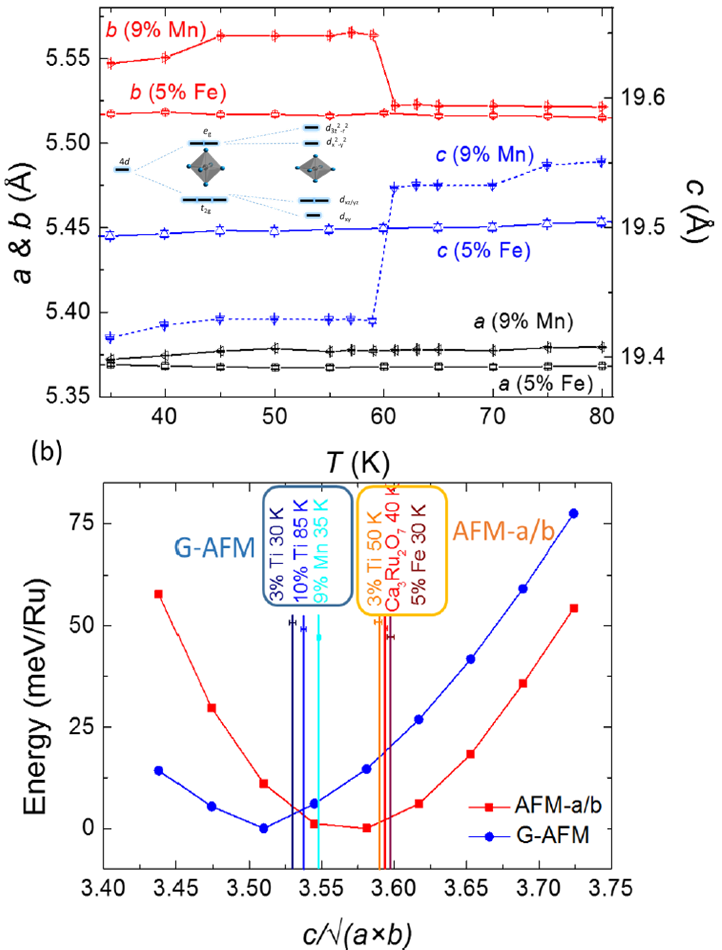
Using the Steady High Magnet Field Facility (SHMFF) at High Magnetic Field Laboratory, Chinese Academy of Sciences (CHMFL), a research group in Nanjing University manages to control the lattice-orbital coupling of the Mott phase transition in double-layered Ruthenates.
Complex interplay among the charge, orbital, lattice, and spin degrees of freedom is believed to underlie the broad range of fascinating phenomena that occurs in strongly correlated electronic systems.
The Ruddlesden-Popper (RP)-type layered ruthenates exhibit a rich variety of different properties, such as spin-triplet superconductivity, a field-tuned electronic nematic phase, itinerant ferromagnetism, an antiferromagnetic (AFM) Mott insulating state, and paramagnetic (PM) "bad" metallicity.
Previous studies showed that a tiny amount of Ti or Mn substitution for Ru can effectively tune the electronic/magnetic states from a PM or nearly ferromagnetic (FM) metallic state to an AFM insulating state.
In contrast, doping with certain other magnetic 3d ions, such as Cr, Co, and Fe, preserves the metallic electronic states of pristine compounds and results in a tendency toward FM ordering.
In the ruthenate compounds, the double-layered Ca3Ru2O7 (n=2) exhibit multiple physical properties and phases.
The spins of Ca3Ru2O7 ordered antiferromagnetically at a Néel temperature TN of 56 K. This AFM state is characterized by FM RuO2 bilayers that are coupled antiferromagnetically along the c-axis with spins pointing along the a-axis.
A first-order metal-insulator transition (MIT) occurs at TMIT = 48K accompanying by a change of the spin direction from along the a-axis to the b-axis.
These two magnetic states were named as AFM-a and AFM-b, respectively.
In this work, the team investigated unusual phase transitions that were triggered by chemical doping in Ca3Ru2O7.
The results showed that a few percentage of (Mn>4%) can change the quasi-two-dimensional metallic state of Ca3Ru2O7 into a Mott insulating state with a G-type AFM order, but this Mott state cannot be induced by Fe doping.
By combining these results with first-principles calculations, it reveals that lattice-orbital coupling (LOC) plays an important role in the Mott transition.
Interestingly, the transition temperature TMIT is found to be predetermined by a structural parameter at temperatures far above TN.
It is addressed that this type of Mott transition originates from the strong scattering centers formed by specific 3d dopants. The dopant-scattering picture is applied to explain the puzzling doping effects that occur in other ruthenates and 3d oxides.
Their findings will advance the general understanding of how the unusual properties of 4d correlated systems are governed by the complex interplay that occurs among the charge, spin, lattice, and orbital degrees of freedom.
The work was supported by the low temperature X-ray diffraction (XRD) facility of SHMFF.
The results have been published in Physical Review B entitled "Mott transition controlled by lattice-orbital coupling in?3d-metal-doped double-layer ruthenates".

Relation between the phase transition and lattice constants: a) The temperature dependence of lattice constants obtained by the low-temperature X-ray diffraction for Ca3(Ru0.91Mn0.09)2O7 and Ca3(Ru0.95Fe0.05)2O7. b) Dependence of the total energy on the structural parameter for the AFM-a/band G-AFM magnetic states, as obtained via DFT calculations. (Image by ZHANG Lei)

86-10-68597521 (day)
86-10-68597289 (night)

86-10-68511095 (day)
86-10-68512458 (night)

cas_en@cas.cn

52 Sanlihe Rd., Xicheng District,
Beijing, China (100864)

